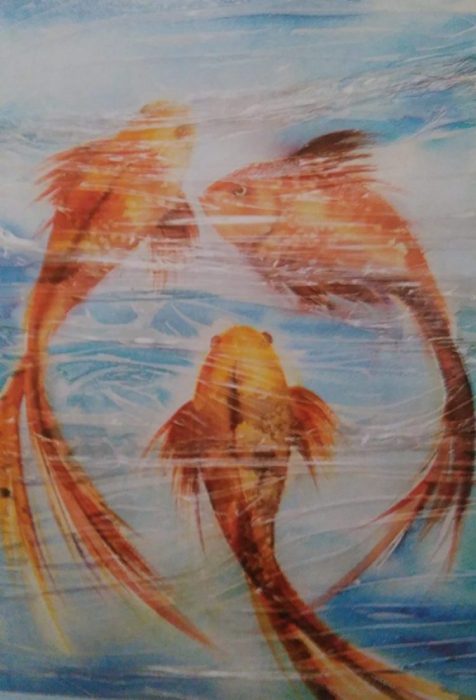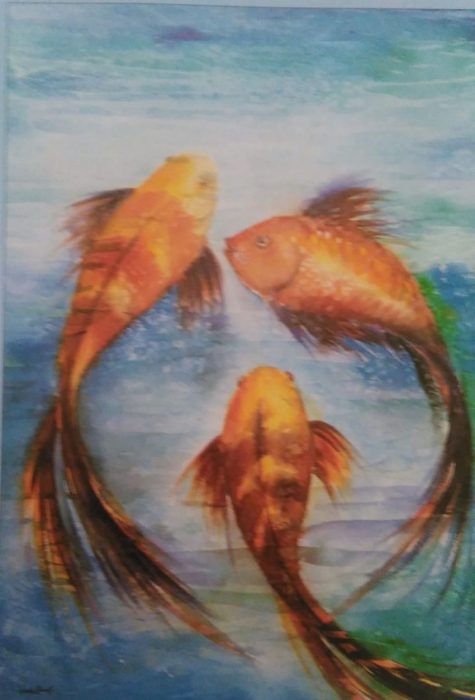There are many tricks you can use to give texture to your watercolor painting. Using unusual methods is fun and lets you express your creativity. Possibilities are limitless if you use your imagination. One of the neat tricks you can use when painting fish with watercolors is creating water texture with plastic foil that is used for wrapping food.
The paint must be wet in order for this technique to work so you better have all that you need for painting already prepared so you can work quickly. Decide what area on your painting you want to texture and place foil on it.
Wrap the foil around the edges of the drawing board if you need it to be tight and then move it and squish it with your fingertips here and there to create ridges. With the foil still on, place your painting on an even flat surface and leave it to dry. Drying period depends on the size of your painting and the level of wetness of the paint.
When you think the paint is dry take the foil off of the painting. You will notice that the paint that was under the ridges have a nice strippy texture with subtle variations of tone.
Fish Under Water
This is one of the examples of how to use plastic foil to create water texture on your watercolor painting. To paint this painting you will need the following:
- A sheet of cold pressed watercolor paper 285g/m2
- Round sable brush number 16
- Round sable brush number 4
- Thin plastic foil
- Kitchen salt
- Gum Arabic
You will also need the following colors:
- Windsor Blue
- Windsor Green
- Cadmium Yellow
- Cadmium Red
- Alizarine Red
- French Ultramarine
- Permanent Gauche White
Sketching

Dilute Cadmium Yellow and paint the shapes of three fish using round sable brush number 16. Pain swiftly and with confidence using the wider part of the brush for the wider part of the fish and the tip of the brush for tales and fins.
Strengthen the tones of the fish using Cadmium Yellow and while the paint is still wet mix Cadmium Yellow and Cadmium Red to get saturated orange and swiftly paint over the fish to give them shape and shade.
Let the spread blend with the first layer of paint creating a mildly round shape of the fish. Use the tip of the brush and with long, swift moves paint tails and fins lifting the brush at the end of each move in order to create a ragged trace that will depict the movement.
Adding The Details
Develop the form of the fish on the right using Alizarine Red darkened with French Ultramarine for the darkest areas on the tails and fins.
While the paint is still wet put a few grains of salt along the body of fish and leave everything to dry for at least ten minutes.After it is dry remove the salt from the painting to reveal the pattern resembling the scales of the fish.
Dip the brush in to clean water and paint with it across the contour of the fish in order to soften the paint thus creating the impression of movement through the water.
Paint the fish at the bottom of the painting with the same colors. Leave it to dry a bit and then paint the eyes of the fish and dark stripes on its back using the mixture of Cadmium Red and French Ultramarine.
Build a striped pattern by adding new layers of paint painted wet on dry. When you finish put a bit of salt on the wet paint and leave it to dry.
Paint the fish on the left in exactly the same manner as you did the other two this time mixing Alizarine Red with a little bit of French Ultramarine for the patterns on the fish. Again use a wet brush to soften the contour in order to create the illusion of water.

Using The Foil
Time to do the fun part. Add clean water on the background of your painting without touching the fish. With a wet paintbrush add wide spreads of Windsor Green and Blue on the wet paper depicting the water.
Slide the brush here and there over the fish so it seems that they are in the water and not on top of it. Add a few grains of salt on the top part of the painting and around the fish tails and fins.
Before the paint is dry stretch a thin plastic foil horizontally over the entire painting. Gently push and pull the foil with your fingers making it twist. Leave it to dry for at least 30 minutes.
Lift the edge of the foil and check if the paint is completely dry. If the paint is dry remove the foil from the painting. Brush off the salt from it. Now you can see the result.

On the areas where the paint was “caught” in the ridges of the foil, it is dried in rigid sharp contours that look like the movements on the water surface.
The patterns that were created by the salt look like the bubbles created by the movement of the fish.
When you are using this technique you have to work quickly because the paint might dry before you manage to add the salt and put the foil on. So if you are painting on the bigger surface first complete one part of the painting than the other.
Finishing Touches
Ad darker tones to fishtails and fins using the mixture of French ultramarine and Alizarine Red.
Using round sable brush number 4 with the same color strengthen the details like the eyes and the mouth of the fish on the right.
Ad more textural details to the fish on the right. Paint the scales on its belly using Alizarine Red with a little French Ultramarine added to make the color darker.
Miix warm gold using Cadmium yellow a little bit of CadmiumRed and Permanent Guache White to give the paint some thickness.
Use this color along the back of the fish. Leave the paint to dry and then add spots of Guache white for lighter areas on the fish.

After the painting is fully dry to the touch go over it with Gum Arabica using round sable brush number 10. Gum Arabica has a role of some kind of lacquer and gives additional shine to the colors.
This technique can be implemented on many subjects you choose to paint. Just use your imagination. If you have any questions regarding the subject feel free to leave them below in the comment section and I will be more than happy to answer them.





0 Comments